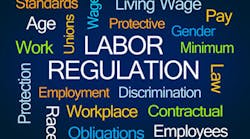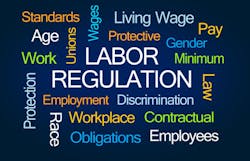New FLSA overtime rules and what they mean for your dental practice
The new Fair Labor Standards Act, or FLSA, applies to all businesses, including dental practices. It's important for dentists/bosses to pay attention to this law so they're in compliance with all labor regulations. The deadline to comply is December 1, 2016.
How many exempt employees work in your dental practice? These are employees who are paid on a salary basis regardless of the number of hours they work, and who are not eligible for overtime pay. Many practices have one or two, often an office manager or a team leader. Regardless of your answer, this number might change in many practices.
In May 2016 the Department of Labor (DOL) announced a new minimum required salary for employees to be considered exempt from overtime pay—$913 per week or $47,476 per year. This is a significant rise, more than double, from the previous minimum, which was only $455 per week or $23,660 per year.
Implementing this change might be difficult, but by December 1 of this year, all employers, including every dental office across the country, must find a way to comply. Practice owners and managers need to evaluate the options for all exempt employees whose salaries currently fall under the new threshold.
RELATED READING:Department of Labor issues Final Rule regarding overtime pay under Fair Labor Standards Act
The statute that determines when an employee can and cannot be classified as exempt is called the Fair Labor Standards Act, or FLSA. When the FLSA was created, exemption applied only to employees who were paid fairly well and whose positions involved some autonomy. However, the salary threshold for exemption became outdated—it was last updated in 2004, and $23,660 per year no longer stretches very far in 2016.
For this reason, the required minimum salary for exemption has now been raised to $913 per week, or $47,476 per year. The DOL’s goal is to move many exempt salaried employees who cannot currently earn overtime into nonexempt status so they can be paid overtime when applicable. Alternatively, employers can raise affected employees’ salaries so they fulfill the requirements for exemption.
Unfortunately, these changes will be disproportionately hard for small businesses. Not every business can afford to increase exempt employees’ pay, reclassify and pay them overtime, or reduce hours and hire additional staff so no one works more than 40 hours per week. Regardless of these difficulties, the DOL’s compliance deadline is December 1, 2016, so it’s time to make plans.
Following the rules: What your practice needs to do
To prepare, first determine how many salaried exempt employees are likely to be affected in your practice. It could be one (maybe even you), none, or several, depending on your business size and specialty.
Remember that exemption is not just a question of whether an employee is paid on a salary basis and above the minimum threshold. There’s a lot more to it. Exempt office managers or team leaders, for example, must spend more than 50% of their time managing at least two other full-time employees, among other requirements. For a so-called “white collar” exemption to apply, the employee’s administrative, executive, or professional job duties must meet a rigorous set of criteria. If all requirements for exemption are not met, an employee is not exempt from overtime pay.
Office managers and team leaders are some of the most likely dental practice employees to be affected by the new FLSA requirements. Hygienists usually should not be considered exempt in the first place. If you do have exempt hygienists, call us at CEDR Solutions to make sure they’ve been classified correctly. Now is your best chance to fix this dangerous issue safely!
What about dentists and associate dentists? They’re exempt under both the current and new law, regardless of their salary (the salary level is not required for doctors). Other dental employees are usually non-exempt, but check with a human resources expert if you have any doubt. Mistakenly assigning exempt status to employees who do not meet the criteria can cause huge expenses for a practice, so you should self-audit regularly to avoid errors, and call us if you need any help.
Once you know which employees will be affected, take steps to prepare. For each previously exempt employee whose salary falls below the new threshold, the practice will need to:
• Increase their salary enough to maintain exemption under the new rules; or
• Accept that this employee is now non-exempt;
• Have all non-exempt employees track their time, and pay them overtime whenever they work more than 40 hours in a workweek (or eight per day in California);
• Consider removing duties or hiring additional staff to limit overtime expenses for any employees whose status changed.
To decide which option is in your financial best interests, check out the overtime calculator.
There’s one more practical consideration that doctors and office managers must keep in mind—no non-exempt employee can ever waive his or her legal right to overtime pay, or can ever work off the clock. Overtime is best prevented in advance by advising employees that it must be authorized first. (This policy should be part of your employee handbook.) The practice can issue a “corrective action” to non-exempt employees who work unauthorized overtime, but all overtime hours must be paid out correctly once they have been worked.
Note that if you practice in California, you will be affected by these rule changes but not as drastically. California’s current exemption rules already require a higher salary threshold than the current federal rule, but it’s less than the new level, so you must comply.
Good, bad, or maybe both
Many dental practice owners and small business owners everywhere are justifiably worried about these new requirements. Payroll expenses could increase drastically if higher salaries or more overtime hours are paid out, and productivity could decrease if you cut back on manager duties to limit overtime. Plus, exempt employees whose salaries are raised might be happy, while others who are reclassified as nonexempt might be annoyed at having to track their hours and give up schedule flexibility. These are difficult choices, but starting your compliance review now will minimize the pain of this transition.
Inconveniences and complexities aside, one good effect of these changes is that they give you a chance to make sure everyone in your office is classified correctly, without raising the usual red “audit” flags caused by switching an employee’s status out of the blue. Doctors and managers, take advantage of this opportunity to review your books and get everything right.


